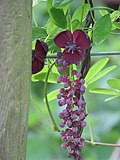Akebia
| Akebia | |
|---|---|

| |
| Akebia quinata | |
| Scientific classification | |
| Kingdom: | Plantae |
| Clade: | Tracheophytes |
| Clade: | Angiosperms |
| Clade: | Eudicots |
| Order: | Ranunculales |
| Family: | Lardizabalaceae |
| Genus: | Akebia Decne.[1] |
| Species | |
|
See text. | |
Akebia is a genus of five species of flowering plant, within the family Lardizabalaceae. The scientific name, akebia, is a Latinization of the Japanese name for species Akebia quinata: akebi (通草).
Species[]
| Flower | Name | Common Name | Distribution |
|---|---|---|---|
| (Quan Xia, J.Z.Sun & Z.X.Peng) Christenh. | China, Japan, Korea, Taiwan | ||
| T. Shimizu | Taiwan | ||
 |
Matsumura | China and Taiwan | |
 |
Akebia quinata (Houttuyn) Decaisne | Chocolate vine or five-leaf akebia | China, Korea and Japan |
 |
(Thunberg) Koidzumi | Three-leaf akebia | China, Korea and Japan |
Hybrids[]
- Akebia ×pentaphylla (Makino) Makino (A. quinata × A. trifoliata)
Fruit[]
Akebia quinata and Akebia trifoliata both bear edible fruit, containing a sweet white flesh.[3] Flavor varies greatly in akebias, even within the same species, with some individuals displaying a complex flavor profile resembling a mixture of banana, passionfruit and lychee, with others being mild, or even insipid.[4]
Akebia in Japan[]
Akebia is often mentioned in Japanese literature, where it is evocative of pastoral settings.[5] Although the akebi commonly refers to the five-leafed species, the three-leafed species is used in much the same way for novelty food, medicine, and for vine material.
While only a minor food eaten while foraging in the past, akebia is considered a specialty crop today, only available when in season. The pods contain a white, semi-translucent gelatinous pulp that is mildly sweet and full of seeds.[6] The taste is described as sweet but rather "insipid".[6] Some people recollect in idyllic terms how they foraged for it in the hills as children.[7]
The purple-colored, slightly bitter rind has been used as a vegetable in Yamagata Prefecture[7][8] or in those northern areas, where the typical recipe calls for stuffing the rind with minced chicken (or pork) flavored with miso.[8] Minor quantities of akebia are shipped to the urban market as a novelty vegetable.
In addition to consuming the fruit, akebia leaves are also made into a tea infusion.[5] Outside of food and drinks, akebia vines are used for basket-weaving crafts. An old source lists Minakuchi, Shiga and Tsugaru (now Aomori Prefecture) as localities that produced baskets from the vines of trifoliate variety.[9]
Gallery[]
Ripe Akebia trifoliata fruit

Akebia quinata leaves and flowers
Female flowers of Akebia quinata (large) and male (small)

Early fruit of Akebia quinata

Akebia quinata flower

Early fruit of Akebia quinata
References[]
- ^ Jump up to: a b "Akebia Decne". Plants of the World Online. Royal Botanic Gardens, Kew. Retrieved 2020-10-10.
- ^ "Akebia". Flora of China. Retrieved 2009-04-05.
- ^ "Akebia quinata". PFAF.
- ^ "Akebia: A Potential New Fruit Crop in China". HortScience.
- ^ Jump up to: a b Davidson, Alan, and Tom Jaine. The Oxford companion to food. Oxford University Press, USA, 2006. 805. Print. Retrieved Aug. 09, 2010, from [1]
- ^ Jump up to: a b Sargent, Charles Sprague (March 25, 1891), "Plant Notes-The Fruit of Akebia quinata (With Figure.)" (google), Garden and Forest, 4 (161): 136
- ^ Jump up to: a b Nimura, Kazuo(二村一夫)r (2006-07-22). "食の自分史" [Self-history on food]. 『食の自分史』. Retrieved 31 January 2017.
- ^ Jump up to: a b Yamagata City Health Center (2011-01-31). "あけびの詰め物" [stuffed akebia]. Archived from the original on 19 October 2011. Retrieved 31 January 2017., photograph shows trifoliate variety (twig, fresh purple plant, and prepared dish)
- ^ Agricultural Society of Japan; Dai Nihon Nōkai(author alia) (1895). Useful plants of Japan: described and illustrated (google). 1. Agricultural Society of Japan. p. 92.
Further reading[]
- Bailey, L. H. (2005). Manual of Gardening (Second ed.). Project Gutenberg Literary Archive Foundation.
External links[]
- Akebia: Three Varieties including photographs by Paghat's Garden
- Akebia: Edible Fruits including photographs by Paghat's Garden
- Lardizabalaceae
- Ranunculales genera
- Japanese vegetables
- Flora of China
- Flora of Eastern Asia
- Medicinal plants of Asia





